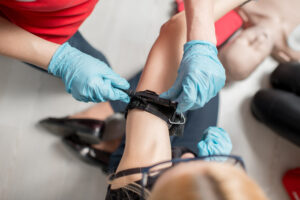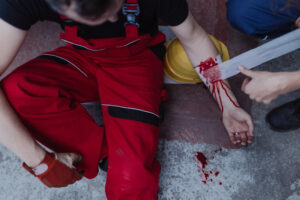 Picture this: you’re on your way to work or school on an uneventful morning. Then, you hear a gunshot from a distance, followed by the sight of a bystander on the ground bleeding out of a gunshot wound. With no doctor or first responder nearby and help from 911 minutes away, all you can do is watch helplessly.
Picture this: you’re on your way to work or school on an uneventful morning. Then, you hear a gunshot from a distance, followed by the sight of a bystander on the ground bleeding out of a gunshot wound. With no doctor or first responder nearby and help from 911 minutes away, all you can do is watch helplessly.
Knowing first aid in such situations can mean the difference between life and death. In fact, there’s no shortage of stories of regular people with first aid training helping save lives on the spot across the country. Bleeding control is one of the fundamentals because it’ll mainly be up to people on the scene to prevent such situations from reaching the point of certain death.
With that, here are some of the basics of bleeding control to keep in mind:
- Your Own Safety Still Takes Priority
In any medical emergency that requires immediate first aid, the safety of the one administering it still takes priority over everything else. In the case of the what-if scenario earlier, the gunman might still be in the vicinity and not hesitate to take the first aider out. A first aider who gets shot, even if only a graze, won’t be of much help to an earlier victim.
Emergency responders know this, so someone only trained in first aid should know this as much. As the situation can change at the drop of a hat, experts advise taking the following tips to heart:
- Identify hazards in the vicinity, including both immediate and unforeseen ones.
- Use the environment to your advantage (e.g., set up a safe zone with barriers)
- If possible, bring the victim to another place nearby.
- If the situation is still too dangerous, prioritize saving yourself.
2. Contact With Blood Can Get You Sick
 Many viruses and other pathogens use blood to transfer from one body to another. According to the National Institute of Occupational Safety and Health, those of utmost concern include HIV and hepatitis. It’s impossible to know if the victim is ill without testing kits, so getting spattered with blood is too much of a risk.
Many viruses and other pathogens use blood to transfer from one body to another. According to the National Institute of Occupational Safety and Health, those of utmost concern include HIV and hepatitis. It’s impossible to know if the victim is ill without testing kits, so getting spattered with blood is too much of a risk.
Speaking of kits, having a complete first aid kit on hand is a must. Manufacturers of first aid gear know the importance of bleeding control and have complete specialized kits that include medical gloves, tourniquets, and instructions on their use. You can browse their help for additional info.
Towels or plastic bags can serve as alternatives if no kit is available. In case of blood spattering on clothes or skin, rinse off the affected part with soap and water or an alcohol-based sanitizer. Once emergency responders arrive, report the spillage and follow their instructions.
3. There May Be More Than One Wound
One thing to safely assume is the possibility that the victim has more than one wound, not just what’s immediately visible. The victim’s clothes may conceal other wounds after an accident. Experts advise awareness of continuous bleeding or a large pool of blood, as such signs can point to severe or life-threatening bleeding.
Speed is of the essence when the victim’s bleeding becomes this severe. The National Library of Medicine says that a person losing a fifth or more of their blood can result in hypovolemic shock. Some of its symptoms include:
- Skin color going pale
- Abnormal rapid breathing
- Lack of responsiveness
- General weakness
- Skin feeling cool to the touch
Experts say the best thing a first aider can do here is to apply enough pressure to the wound until help arrives. A tourniquet works best for life-threatening bleeding in the arms or legs, but using one requires training. Alternatively, you can use gauze by applying pressure or packing as much as necessary to plug large wounds.
Doctors advise against makeshift tourniquets, particularly ones made with bandages or bandanas. One study in 2015 found that such improvisations are between 60% and 90% less effective than dedicated ones.
4. Don’t Attempt To Remove Objects
If a piece of debris causes bleeding, medical experts don’t advise taking it out. As much as it hurts the victim, this solid piece keeps the bleeding to a manageable level. Instead, they suggest wrapping enough bandages around the object to prevent it from moving and leaving the removal to the doctors.
However, objects like wood splinters or thorns may require immediate removal. They may push deeper into the wound and trigger an infection over time. A pair of tweezers can help do the job.
Conclusion
To medical practitioners, if there’s something more tragic than death, it’s a death that could’ve been averted. Every second the victim doesn’t receive medical attention is every second they draw closer to the inevitable. Regardless of medical experience, a person well-trained in first aid nearby can increase the chance of saving a life.


